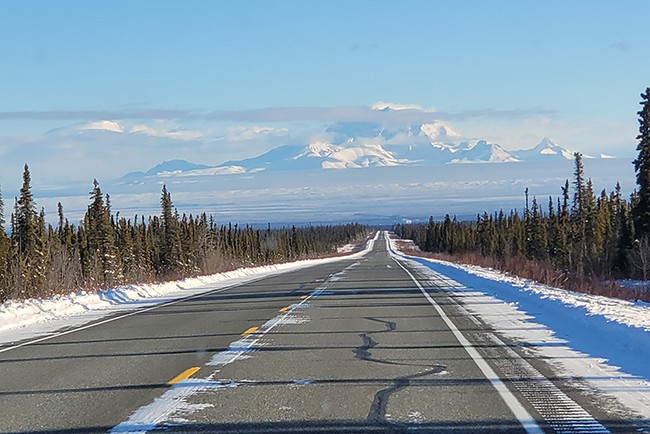
Nature can make us feel pretty small.
In the years I lived in Colorado, east of Denver, I had the habit of taking visitors up Smoky Hill Road to the high prairie southeast of the metropolitan area. There was one high place where one could pull off the road (it wasn’t all built up with houses and shopping centers then) and see the tall buildings of downtown Denver, that great city of the plains – looking very, very small, down there in the South Platte valley, with the mighty Front Range completely overshadowing the city.
Advertisement
It’s an interesting perspective. Now here, in Alaska, there is a lot that can make a person feel pretty small. On a clear day, you can see the Alaska Range from 150 miles away; Alaska is a vast, vast place, mostly empty of people, and there are places where, if you leave the highway and start walking in a given direction, you would never encounter another human – ever.
In southeast Alaska, near the border with Canada’s Yukon Territory, stands Mount Churchill. Mount Churchill is a volcano and one that has the potential to make the entire Northern Hemisphere feel kind of small.
Mount Churchill stands in a white corner of the Alaska map, deceptive in its cold, windblown silence. At least twice in the last few thousand years, the peak’s ice-covered caldera has spewed ash that reached as far as Ireland and piled up to force northern animals out of the territory.
The Alaska Highway and other northern roads are striped with layers of “White River ash” spewed from the volcanic field near Mount Churchill. UAF anthropologists dated ash from a northern lobe to about the year A.D. 420. Another massive plume that winds carried to the east was from an eruption in about the year A.D. 846.
A similar eruption today would bring much of the Northern Hemisphere to a standstill — grounding planes and burying parts of Alaska and Canada with inches or feet of ash.
Advertisement
The prevailing winds would take (hopefully) most of the ash away from south-central Alaska, where my hat hangs – but the effects would still be bad.
A geologist from the University of Alaska Fairbanks is trying to determine when and if Mount Churchill might blow its top again.
For this reason, during the past few summers, Larsen, a University of Alaska Fairbanks professor of volcanology, has guided students on field trips to sites in Alaska and the Yukon Territory. She and her students look for clues that might help them estimate when another Churchill super eruption might happen.
Researchers from Edmonton, Alberta, postulated that ashfall from the most recent eruption disrupted the migration paths of caribou and salmon. That might have pushed ancient people of the Yukon and Northwest territories as far as the southwestern United States.
An eruption like that today — twice as large as the one that created Alaska’s Valley of 10,000 Smokes — would ground flights on the great circle route that most commercial pilots fly from the Lower 48 to Asia. Chaos would reign wherever ash blanketed the ground.
In the immortal words of another famous scientist, it would be… bad.
See Related: Danger in the Pacific Northwest: What’s Worrying Geologists Most?
Advertisement
Unexpected Thanksgiving Memory, a Live Volcano, and a Moving Torch
Still, as the saying goes, ain’t no reason to get excited. Studying things like this is worth doing, and if these geologists can give us a little bit of warning before a major volcano goes off, allowing for some preparation, that’s all for the good. But a foot of volcanic ash dropping across much of North America isn’t really something one can prep for; it’s only something one can try to get out of the way of. While volcanic ash can be good for the soil – just ask the people who have vineyards on the slopes of Vesuvius – it can be deadly when it’s coming down. It’s almost pure silica; breathing in the ash is like breathing in millions of tiny razors and can badly damage your lungs, a condition called silicosis.
While this is one of those things that we must have the wisdom to accept, though, I at least still find it interesting – and it lends one some perspective. We are a tiny part of this big planet, and once in a while that planet burps up something to remind us of our place in the natural world. A volcano, an earthquake, a tsunami, a flood, and generations’ worth of human effort can be wiped away in a matter of hours – or minutes.
Advertisement
Sometimes it hits us very close to home. My parents, after the 2007 and 2008 floods that hit much of the upper Midwest, were forced out of the Allamakee County home where I grew up after they had lived for over three decades. The lovely trout stream that lent its name to their place – Bear Creek – overran its banks two years in a row, and in 2008, the Old Man, then 85, decided he couldn’t keep it up anymore.
It makes one think. But it shouldn’t make us worry. We should only worry about things we can change.
